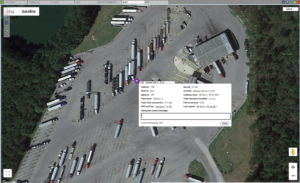Drivers are the lifeblood of the trucking industry, but they’re not the only employees responsible for success. Dispatchers play an essential role in every trucking business, scheduling drivers, flagging issues, negotiating freight, and ensuring smooth operations. While the job entails a variety of different tasks, many technologies can make life easier for dispatchers.
Let’s look at how to empower your dispatch teams with telematics to make their lives easier and operations more efficient.
Dispatchers are essential to the success of every trucking business, and empowering them with technology can help ensure smooth operations. Share on XAsset Visibility with GPS
Telematics with GPS technology integrated into Transportation Management Systems (TMS) or Enterprise Resource Planning (ERP) software enables dispatchers to see their entire fleet of assets on a single screen. Using these real-time locations, dispatchers can send their closest drivers to a location, update customers when deliveries are running late or ahead of schedule, and document arrival and departure times for detention billing, among other things.
Of course, GPS is also invaluable when dealing with weather, road closures, and other traffic delays. For example, a dispatcher may identify road closures due to construction or traffic before drivers are, enabling them to alert drivers and reroute trucks to avoid traffic and aid in timely delivery of cargo to customers.
In addition to tracking trucks, dispatchers can use GPS technology to track trailers or containers across intermodal transportation. So, for example, trucking companies can eliminate the need for time-consuming yard checks while efficiently providing customers with updates on shipments throughout their journey.
The data from GPS technologies can also be aggregated and analyzed over time to identify trends. Dispatchers may use these trends to plan the most efficient schedules, avoid congested areas, identify longer dwell times at certain landmarks, and improve customer relations. Managers can also access detailed driver performance data to help them address any problems and ensure the fleet operates at maximum safety and efficiency.
Driver Communication with ELDs
Driver communication involves much more than smartphones. For example, drivers need to record Hours of Service (HOS), receive clear job orders, and complete daily vehicle inspection reports (DVIRs). At the same time, dispatchers may need to know the truck’s location, fuel levels, or access historical trip data to do their jobs effectively.

Powerfleet’s LV-9000 is a modern ELD that provides more functionality. Source: Powerfleet
Fortunately, modern in-cab telematics go well beyond electronic logging devices (ELDs). For instance, Powerfleet’s LV-9000 supports complex driver workflows, minute-by-minute updates, and a continuous connection to send and receive job orders, trip data, text messages, GPS position data, fuel consumption analytics, and more.
For example, a dispatcher can easily monitor drivers’ daily logs for errors or violations while simultaneously monitoring working hours and equipment health—all without needing to contact the driver directly. Thanks to onboard telematics solutions and cellular networks, they can access all this information in the cloud.
Powerfleet’s technology also enables drivers to stay connected via mobile device apps, meaning that they can respond to messages and complete jobs outside of the truck’s cab. These capabilities can be incredibly convenient when trucks are parked or when drivers are outside of their vehicle at a fuel or rest stop.
Reefer Management with Sensors
Refrigerated trucks, or reefers, help deliver fresh produce, pharmaceuticals, and other temperature-sensitive products across the country. Since these products can spoil, the federal government developed the Food Safety and Modernization Act (FSMA) to avoid spoilage and ensure food safety across the supply chain.
The FSMA regulations require shippers to maintain a clean trailer, pre-cool the trailer before loading, monitor temperatures during travel, maintain reefer fuel levels, and keep records to prove safe transport. In many cases, dispatchers help drivers monitor temperatures and other alerts or fault codes during the transit to avoid expensive spoilage claims.
Two-way remote communication and real-time temperature sensors enable dispatchers to react to any problems quickly. For example, a dispatcher can remotely control/adjust the temperature of the trailer without involving the driver. In addition, Powerfleet’s LV-400 automatically records refrigerated unit engine hours and fault codes to improve preventive maintenance scheduling and ensure accurate temperature management at all times.
In addition to sensors, fleets might use humidity, pressure, or light sensors to ensure optimal cargo conditions. Door sensors and IR LED cameras can also help prevent cargo theft, particularly with pharmaceuticals and other high-value cargo transported in refrigerated trailers across the United States.
Maximizing Data Accessibility
Telematics solutions provide a wealth of data, but it needs to be easily accessible. Dispatchers must quickly locate information and convert it into actionable insights for drivers or managers—ideally without having to run complex or time-consuming reports. Unfortunately, many telematics solutions providers neglect these requirements.

Powerfleet’s dashboard makes it easy to track assets in the yard or on the road. Source: Powerfleet
Powerfleet provides a real-time, web-based dashboard that makes it easy to find information at a glance. In addition to leveraging data on the job, dispatch can be an entry point to other careers within an organization—often a management track. Providing dispatchers with a high level of data can help them make data-driven decisions and recognize trends that can ultimately help them deliver more value to the organization in other roles.
The Bottom Line
Dispatchers are responsible for everything from monitoring drivers’ daily logs to coordinating deliveries, making them an essential part of any trucking operation. While the job entails a variety of different tasks, many technologies can help automate manual workflows and keep everything running a lot more smoothly to maximize productivity.
Powerfleet provides a full range of telematics solutions covering everything from materials handling in the warehouse to last-mile delivery to the customer—and everything in between.
Learn more about our logistics solutions or contact us to schedule a free consultation!






